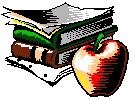 Rethinking
The Academy:
Rethinking
The Academy: Rethinking
The Academy:
Rethinking
The Academy:Hypertext links are the heart of web-based writing; set by the author of the text, they can be clicked on via a mouse by the reader.
For instance, this link will send me e-mail. This one could send you to my home page out on www.uic.edu - which leads directly to my real home page on www2.uic.edu.
(Of course, if you want, you can have the table of contents for this essay back....)
Because I've included links outside the text proper, my reader has the ability to leave my essay, my dissertation; from my pages, she can go many places in and on the Internet, and may not choose to return to my text.
This freedom of the reader affects the very organization of the essay or art work that is presented in hypertextual format.
Traditional or linear texts assume a certain order or organization - one reads chapter one in order to gain the experience necessary to read chapter two and an author does not take responsibility for the reader who skips chapters and, therefore, steps in her argument. Even this, which seems so axiomatic for Western readers, is called into question by the existence of the index, a way of forcing the reader's organization onto the author. The reader using an index can read in any chosen order, and can ignore any given step in the argument.
Nonetheless, as Nicholas Negroponte puts it,
[in] a printed book, sentence, paragraphs, pages, and chapters follow one another an order determined not only by the author but also by the physical and sequential construct of the book itself. While a book may be randomly accessible and your eyes may browse quite haphazardly, it is nonetheless forever fixed by the confines of the physical dimensions. (69)
Last Modified: August 2, 1996
Copyright © 1996 by Keith Dorwick